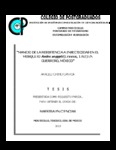| dc.description.abstract | El dengue es una de las enfermedades más graves a nivel mundial en salud pública, y a la fecha el uso de insecticidas químicos ha sido la principal medida de control del vector Aedes aegypti transmisor del virus causal del dengue. Con la finalidad de aportar bases para definir una estrategia de manejo regional de insecticidas, se determinó la susceptibilidad de poblaciones de Aedes aegypti L., provenientes de tres regiones de Guerrero, México (Tierra Caliente, Costa Chica y Acapulco), a los insecticidas malatión, temefos, clorpirifós étilico, pirimifós-metil, permetrina, lambda cialotrina, propoxur y espinosina. La población susceptible New Orleans se usó como referencia. Los productos en grado técnico y comercial se evaluaron por aplicación residual en larvas de cuarto estadio temprano, de acuerdo a la metodología propuesta por la Organización Mundial de la Salud (OMS). La mortalidad se registró 24 h después de aplicar los insecticidas y mediante análisis Probit se determinaron los valores de las CL50 y el factor de resistencia para cada producto. Las tres poblaciones de A. aegypti resultaron resistentes al insecticida lambda-cialotrina, y las provenientes de la Costa Chica y Acapulco moderadamente resistentes al pirimifós-metil. En contraste, las tres poblaciones mostraron susceptibilidad al insecticida malatión, temefós, clorpirifós, permetrina, propoxur y espinosina. No obstante, aunque la mayor cantidad de los productos evaluados resultaron efectivos, se recomienda que estos se usen en rotación con insecticidas de diferente modo de acción y en conjunto con otras alternativas, como la remoción de criaderos, a fin de conservar la vida útil de los productos autorizados. El presente trabajo aporta información referencial de gran utilidad para el desarrollo e implementación de estrategias para el manejo y vigilancia de la resistencia de A. aegypti a insecticidas a nivel regional en Guerrero, México. _______________ RESISTANCE MANAGEMENT TO INSECTICIDES IN Aedes aegypti (Linneus, 1762) FROM GUERRERO, MÉXICO. ABSTRACT: Dengue fever is one of the most serious diseases in public health around the world, and chemical insecticides have been the most important management strategy used to control the mosquito Aedes aegypti, dengue virus vector. In order to provide bases to define a regional insecticide management strategy, the susceptibility of populations of Aedes aegypti from three regions of Guerrero, México (Tierra Caliente, Costa Chica and Acapulco), to insecticides malathion, temephos, chlorpyriphos, pirimiphos-metil, permethrin, lambda-cyhalothrin, propoxur, and spinosin was determinated. The New Orleans population was used as a reference. Commercial and technical grade insecticides were evaluated by residual application in early fourth instar larvae according to the methodology proposed by the World Health Organization (WHO). The mortality was recorded 24 h after of exposure. Probit analysis was used to determine the response lines log dose-mortality, LC50 values and the resistant factor for each product. Results indicated that the three populations of A. aegypti were resistant to the insecticide lambda cyhalothrin, and the populations from Acapulco and Costa Chica were moderately resistant to pirimiphos methyl. In contrast, the three field populations were susceptible to malathion, temephos, chlorpyriphos, permethrin, propoxur and spinosin. However, although some products were found to be effective, it is recommended to use them in a rotation bases combining different mode of action insecticides and in conjunction with other alternatives, as removal of breeding sites, to preserve the effective life of authorized products. This study provides useful reference information for the development and implementation of strategies for the managing and monitoring local insecticide resistance of A. aegypti, in Guerrero, México. | en_US |


